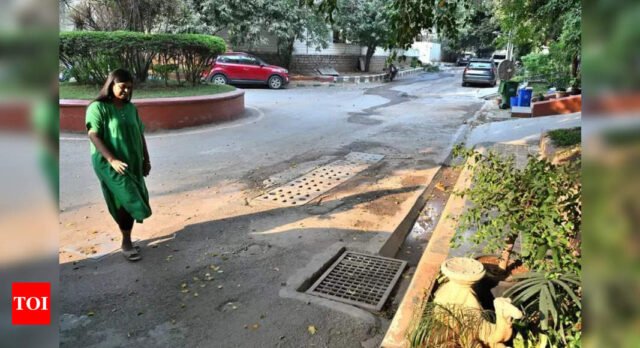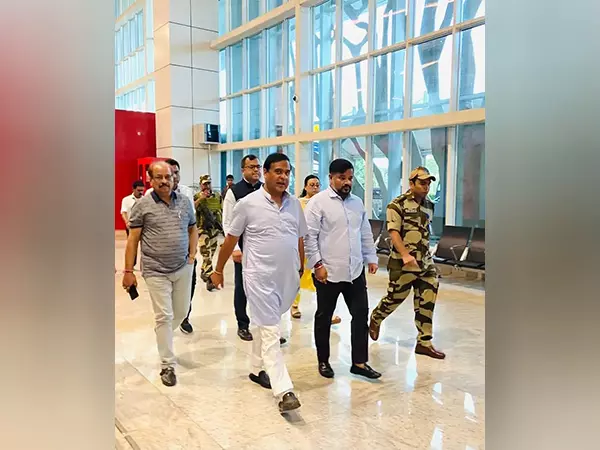SOCIETY SAYS BYE TO TANKERS
At Aparna Towers in Kondapur, discussions on water conservation began six years ago. “The society has installed several rainwater harvesting pits to store monsoon rainfall for the drier months of Feb to June,” says Dr Sai Ravi Shankar, a resident and president of the Federation of Gated Communities, adding that they haven’t had to rely on water tankers for the past three years.
As well as harvesting rainwater, the community, which has around 380 flats, also has a sewage treatment plant (STP) to filter the water it uses.
Shankar says: “While borewells in other areas of the city, which used to provide water at a depth of 250 metres, now run dry at depths of 750 to 850 metres, in Kondapur, we expect to be able to use groundwater till 2027.” He added that the situation in major residential areas like Banjara Hills and Jubilee Hills was worrying.
In the colony, 50% of the total water is used for flushing tanks and gardening and the remaining 30% is used for other activities in and around the premises, says Shankar
The Federation conducts regular meetings to educate residents about rainwater harvesting, STPs, and how to conserve and use water wisely.
WATER HARVESTING: 30 YEARS & GOING STRONG
While residents in areas like Ameerpet and SR Nagar are forced to spend lakhs on tankers, Methodist Colony in neighbouring Begumpet has been practicing water conservation since 2003, with large-scale rainwater harvesting introduced in 2016.
Many households in the colony have been harvesting rainwater for more than 30 years, using it for daily needs such as cooking, cleaning and irrigation.
Gita Dendukuri, a resident, says the colony has four large pits and 30 smaller pits in low-lying areas, and rainwater flows directly into these pits instead of stagnating or being lost as runoff.
“Some of the water harvested is used immediately, while the rest is left to recharge the water table. This long-term planning ensures that the underground reserves remain stable, benefiting not only the current months but also the months to come,” explains Gita.
“I use the water for my kitchen needs and also for cleaning the house. Even our hand pumps work during the extreme summer, indicating that the water level is over 100 feet. This has also reduced flooding in the area over the years,” adds Gita.
“Each pit in our colony fills up to 20-25 feet during the monsoon and the water later seeps into the ground. Almost all the areas around our colony, like Ameerpet and Prakash Nagar, depend on water tankers, but in the last eight years, I can’t remember getting even a single tanker,” said a 38-year-old resident of the colony.
MILLIONS OF LITRES OF WATER SAVED
Similarly, Rolling Hills in Gachibowli has 26 rainwater harvesting pits and 13 injection borewells. Over the past 13 years, the 100-house community has saved millions of litres of water, thanks to rainwater harvesting pits, filtration systems and even STPs for efficient water management.
Kalpana Ramesh, a resident who has also worked on water conservation initiatives across the city, explained that borewells provide access to underground water by drilling deep into the earth. A pump is used to bring the water up when the natural pressure isn’t enough. Their effectiveness depends on groundwater levels and proper maintenance. On the other hand, wastewater treatment plants treat used water from homes and buildings, removing impurities before it is safely discharged. If the wastewater can’t reach the plant naturally because of uneven land, pumps are used to direct the flow.
This combination of systems allows the community to collect about 1.5 million litres a year, enough to supply most homes.
Kalpana stressed the importance of community-driven solutions. “Rainwater harvesting is not just about collecting water, it’s about creating a long-term strategy. Communities need to actively plan, educate residents and ensure maintenance of these systems,” she said.
TREES SOAK UP THE RAIN
Rock Town Colony in Chanakyapuri has taken extra steps to ensure that water is conserved. Apart from rainwater harvesting, residents have also planted trees to effectively absorb rainwater into the soil.
Ravinder Reddy, a resident, said: “We started harvesting rainwater and educating residents two years ago. Today, with 200 houses, we are no longer dependent on tankers. This success has encouraged us to plan better for the future.”
The area has several rainwater harvesting pits that store monsoon water for long-term use, mainly for cleaning and kitchen needs. Reddy explains that the decision to plant trees has helped the water percolate into the ground, improving the water table. “Rainwater harvesting is a practical solution to urban water scarcity. We save the cost of water tankers, reduce wastage and reuse the water,” he added.
QUOTE
We were only madated to raise awareness among the residents and educate them to install water harvesting systems. That was not our responsibility. We did a survey to understand how many colonies had pits. The mandate was to ensure that pits and borewells were followed.
— HMWSSB official
At Aparna Towers in Kondapur, discussions on water conservation began six years ago. “The society has installed several rainwater harvesting pits to store monsoon rainfall for the drier months of Feb to June,” says Dr Sai Ravi Shankar, a resident and president of the Federation of Gated Communities, adding that they haven’t had to rely on water tankers for the past three years.
As well as harvesting rainwater, the community, which has around 380 flats, also has a sewage treatment plant (STP) to filter the water it uses.
Shankar says: “While borewells in other areas of the city, which used to provide water at a depth of 250 metres, now run dry at depths of 750 to 850 metres, in Kondapur, we expect to be able to use groundwater till 2027.” He added that the situation in major residential areas like Banjara Hills and Jubilee Hills was worrying.
In the colony, 50% of the total water is used for flushing tanks and gardening and the remaining 30% is used for other activities in and around the premises, says Shankar
The Federation conducts regular meetings to educate residents about rainwater harvesting, STPs, and how to conserve and use water wisely.
WATER HARVESTING: 30 YEARS & GOING STRONG
While residents in areas like Ameerpet and SR Nagar are forced to spend lakhs on tankers, Methodist Colony in neighbouring Begumpet has been practicing water conservation since 2003, with large-scale rainwater harvesting introduced in 2016.
Many households in the colony have been harvesting rainwater for more than 30 years, using it for daily needs such as cooking, cleaning and irrigation.
Gita Dendukuri, a resident, says the colony has four large pits and 30 smaller pits in low-lying areas, and rainwater flows directly into these pits instead of stagnating or being lost as runoff.
“Some of the water harvested is used immediately, while the rest is left to recharge the water table. This long-term planning ensures that the underground reserves remain stable, benefiting not only the current months but also the months to come,” explains Gita.
“I use the water for my kitchen needs and also for cleaning the house. Even our hand pumps work during the extreme summer, indicating that the water level is over 100 feet. This has also reduced flooding in the area over the years,” adds Gita.
“Each pit in our colony fills up to 20-25 feet during the monsoon and the water later seeps into the ground. Almost all the areas around our colony, like Ameerpet and Prakash Nagar, depend on water tankers, but in the last eight years, I can’t remember getting even a single tanker,” said a 38-year-old resident of the colony.
MILLIONS OF LITRES OF WATER SAVED
Similarly, Rolling Hills in Gachibowli has 26 rainwater harvesting pits and 13 injection borewells. Over the past 13 years, the 100-house community has saved millions of litres of water, thanks to rainwater harvesting pits, filtration systems and even STPs for efficient water management.
Kalpana Ramesh, a resident who has also worked on water conservation initiatives across the city, explained that borewells provide access to underground water by drilling deep into the earth. A pump is used to bring the water up when the natural pressure isn’t enough. Their effectiveness depends on groundwater levels and proper maintenance. On the other hand, wastewater treatment plants treat used water from homes and buildings, removing impurities before it is safely discharged. If the wastewater can’t reach the plant naturally because of uneven land, pumps are used to direct the flow.
This combination of systems allows the community to collect about 1.5 million litres a year, enough to supply most homes.
Kalpana stressed the importance of community-driven solutions. “Rainwater harvesting is not just about collecting water, it’s about creating a long-term strategy. Communities need to actively plan, educate residents and ensure maintenance of these systems,” she said.
TREES SOAK UP THE RAIN
Rock Town Colony in Chanakyapuri has taken extra steps to ensure that water is conserved. Apart from rainwater harvesting, residents have also planted trees to effectively absorb rainwater into the soil.
Ravinder Reddy, a resident, said: “We started harvesting rainwater and educating residents two years ago. Today, with 200 houses, we are no longer dependent on tankers. This success has encouraged us to plan better for the future.”
The area has several rainwater harvesting pits that store monsoon water for long-term use, mainly for cleaning and kitchen needs. Reddy explains that the decision to plant trees has helped the water percolate into the ground, improving the water table. “Rainwater harvesting is a practical solution to urban water scarcity. We save the cost of water tankers, reduce wastage and reuse the water,” he added.
QUOTE
We were only madated to raise awareness among the residents and educate them to install water harvesting systems. That was not our responsibility. We did a survey to understand how many colonies had pits. The mandate was to ensure that pits and borewells were followed.
— HMWSSB official






